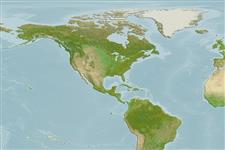Aves |
Procellariiformes |
Procellariidae
Environment: milieu / climate zone / depth range / distribution range
Ecology
Others; depth range 0 - 5 m (Ref. 119695). Tropical; 4°S - 31°S, 159°W - 105°W
Distribution
Countries | FAO areas | Ecosystems | Occurrences | Introductions
Pacific Ocean: Easter Island, French Polynesia and Pitcairn. Tropical to subtropical.
Length at first maturity / Size / Weight / Age
Maturity: Lm ? range ? - ? cmmax. published weight: 0.00 g (Ref. 356)
Eradication of the predator Kiore has been done to conserve this bird species, to administer recovery and recolonization of seabirds (Ref. 87924). Minimum and maximum depth ranges are based on feeding behavior of surface-seizer type of seabirds (Ref. 119695). This is to be replaced with better references. Exhibits surface seizing (Ref. 356). Population decline rate observed at the arrival of Kiore predator (Ref. 87924).
Life cycle and mating behavior
Maturity | Reproduction | Spawning | Eggs | Fecundity | Larvae
Brooke, M. de L. 1995 The breeding biology of the gadfly petrels Pterodroma spp. of the Pitcairn Islands: characteristics, population sizes and controls. Biological Journal of the Linnean Society 56:213-231. (Ref. 5720)
IUCN Red List Status
(Ref. 130435: Version 2025-1)
CITES status (Ref. 108899)
Not Evaluated
Threat to humans
Human uses
| FishSource |
Tools
More information
Population dynamicsGrowthMax. ages / sizesLength-weight rel.Length-length rel.Length-frequenciesMass conversionAbundance Life cycleReproduction
Maturity
Fecundity
Spawning
Eggs
Egg development
Larvae
PhysiologyOxygen consumption
Human RelatedStamps, coins, misc.
Internet sources
Estimates based on models
Resilience
High, minimum population doubling time less than 15 months (K=17.7-44).
